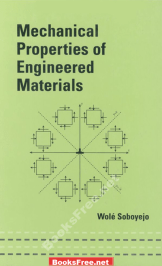| Book Name: | [PDF] Mechanical Properties of Engineered Materials by Wole Soboyejo |
| Free Download: | Available |

| Ebook Particulars : | |
|---|---|
| Language | English |
| Pages | 584 |
| Format | |
| Dimension | 8.70 MB |
Mechanical Properties of Engineered Materials by Wole Soboyejo
Contents of Mechanical Properties of Engineered Materials by Wole Soboyejo eBook
1. Overview of Crystal/Defect Construction and Mechanical Properties and Habits
– Introduction.
– Atomic Construction.
– Chemical Bonds.
– Construction of Solids.
– Structural Size Scales: Nanostructure, Microstructure, and Macrostructure.
2. Defect Construction and Mechanical Properties
– Indicial Notation for Atomic Planes and Instructions.
– Defects.
– Thermal Vibrations and Microstructural Evolution.
– Overview of Mechanical Habits.
3. Primary Definitions of Stress and Pressure
– Primary Definitions of Stress.
– Primary Definitions of Pressure.
– Mohr’s Circle of Stress and Pressure.
– Computation of Principal Stresses and Principal Strains.
– Hydrostatic and Deviatoric Stress Parts.
– Pressure Measurement.
– Mechanical Testing.
4. Introduction to Elastic Habits
– Causes for Elastic Habits.
– Introduction to Linear Elasticity.
– Principle of Elasticity.
– Introduction to Tensor Notation.
– Generalized Kind of Linear Elasticity.
– Pressure Vitality Density Operate.
5. Introduction to Plasticity
– Bodily Foundation for Plasticity.
– Elastic–Plastic Habits.
– Empirical Stress–Pressure Relationships.
– Considere Criterion.
– Yielding Below Multiaxial Loading.
– Introduction to J2 Deformation Principle.
– Movement and Evolutionary Equations (Constitutive Equations of Plasticity).
6. Introduction to Dislocation Mechanics
– Theoretical Shear Power of a Crystalline Stable.
– Varieties of Dislocations.
– Motion of Dislocations.
– Experimental Observations of Dislocations.
– Stress Fields Round Dislocations.
– Pressure Energies.
– Forces on Dislocations.
– Forces Between Dislocations.
– Forces Between Dislocations and Free Surfaces.
7. Dislocations and Plastic Deformation
– Dislocation Movement in Crystals.
– Dislocation Velocity.
– Dislocation Interactions.
– Dislocation Bowing Because of Line Stress.
– Dislocation Multiplication.
– Contributions from Dislocation Density to Macroscopic Pressure.
– Crystal Construction and Dislocation Movement.
– Important Resolved Shear Stress and Slip in Single Crystals.
– Slip in Polycrystals.
– Geometrically Crucial and Statistically Saved Dislocations.
– Dislocation Pile-Ups and Bauschinger Impact.
– Mechanical Instabilities and Anomalous/Serrated Yielding.
8. Dislocation Strengthening Mechanisms
– Dislocation Interactions with Obstacles.
– Stable Answer Strengthening.
– Dislocation Strengthening.
– Grain Boundary Strengthening.
– Precipitation Strengthening.
– Dispersion Strengthening.
– Total Superposition.
9. Introduction to Composites
– Varieties of Composite Materials.
– Rule-of-Combination Principle.
– Deformation Habits of Unidirectional Composites.
– Matrix versus Composite Failure Modes in Unidirectional Composites.
– Failure of Off-Axis Composites.
– Results of Whisker/Fiber Size on Composite Power and Modulus.
– Constituent and Composite Properties.
– Statistical Variations in Composite Power.
10. Additional Subjects in Composites
– Unidirectional Laminates.
– Off-Axis Laminates.
– Multiply Laminates.
– Composite Ply Design.
– Composite Failure Standards.
– Shear Lag Principle.
– The Position of Interfaces.
11. Fundamentals of Fracture Mechanics
– Fundamentals of Fracture Mechanics.
– Notch Focus Elements.
– Griffith Fracture Evaluation.
– Vitality Launch Price and Compliance.
– Linear Elastic Fracture Mechanics.
– Elastic–Plastic Fracture Mechanics.
– Fracture Initiation and Resistance.
– Interfacial Fracture Mechanics.
– Dynamic Fracture Mechanics.
12. Mechanisms of Fracture
– Fractographic Evaluation.
– Toughness and Fracture Course of Zones.
– Mechanisms of Fracture in Metals and Their Alloys.
– Fracture of Intermetallics.
– Fracture of Ceramics.
– Fracture of Polymers.
– Fracture of Composites.
– Quantitative Fractography.
– Thermal Shock Response.
13. Toughening Mechanisms
– Toughening and Tensile Power.
– Evaluate of Composite Materials.
– Transformation Toughening.
– Crack Bridging.
– Crack-Tip Blunting.
– Crack Deflection.
– Twin Toughening.
– Crack Trapping.
– Microcrack Shielding/Antishielding.
– Linear Superposition Idea.
– Synergistic Toughening Idea.
– Toughening of Polymers.
14. Fatigue of Materials
– Micromechanisms of Fatigue Crack Initiation.
– Micromechanisms of Fatigue Crack Propagation.
– Typical Strategy to Fatigue.
– Differential Strategy to Fatigue.
– Fatigue Crack Development in Ductile Solids.
– Fatigue of Polymers.
– Fatigue of Brittle Solids.
– Crack Closure.
– Quick Crack Downside.
– Fatigue Development Legal guidelines and Fatigue Life Prediction.
– Fatigue of Composites.
15. Introduction to Viscoelasticity, Creep, and Creep Crack Development
– Creep and Viscoelasticity in Polymers.
– Mechanical Dumping.
– Temperature Dependence of Time-Dependent Movement in Polymers.
– Introduction to Creep in Metallic and Ceramic Materials.
– Practical Kinds within the Completely different Creep Regimes.
– Secondary Creep Deformation and Diffusion.
– Mechanisms of Creep Deformation.
– Creep Life Prediction.
– Creep Design Approaches.
– Threshold Stress Results.
– Creep in Composite Materials.
– Thermostructural Materials.
– Introduction to Superplasticity.
-Introduction to Creep Harm and Time-Dependent Fracture Mechanics.
Mechanical Properties Of Engineered Materials PDF
Author(s): Wole Soboyejo
Series: Mechanical engineering 152
Publisher: Marcel Dekker, Year: 2003
ISBN: 9780824789008
Related Results : mechanical properties of engineered materials,mechanical properties of engineered materials pdf,
Related More Books
See More POST On : Mechanical Books



